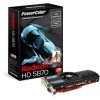- Qualcomm Launches Snapdragon 4 Gen 2 Mobile Platform
- AMD Launches Ryzen PRO 7000 Series Mobile & Desktop Platform
- Intel Launches Sleek Single-Slot Arc Pro A60 Workstation Graphics Card
- NVIDIA Announces Latest Ada Lovelace Additions: GeForce RTX 4060 Ti & RTX 4060
- Maxon Redshift With AMD Radeon GPU Rendering Support Now Available
PowerColor Radeon HD 5870 PCS+

NVIDIA might have hoped for otherwise, but even after the GTX 480’s launch, AMD’s Radeon HD 5870 still proves to be an excellent choice for the price-point. We’re taking a look at PowerColor’s PCS+ version here, which includes a robust cooler, quieter operation, a slight overclock, and a complete copy of Call of Duty: Modern Warfare 2.
Page 11 – Overclocking PowerColor’s Radeon HD 5870 PCS+
Before tackling our overclocking results, let’s first clear up what we consider to be a real overclock and how we go about achieving it. If you read our processor reviews, you might already be aware that we don’t care too much for an unstable overclock. It might look good on paper, but if it’s not stable, then it won’t be used. Very few people purchase a new GPU for the sole purpose of finding the maximum overclock, which is why we focus on finding what’s stable and usable.
To find the max stable overclock on an ATI card, we stick to using ATI’s Catalyst Overdrive tool. Compared to what’s available on the NVIDIA side, it’s quite limited in the top-end, but it’s the most robust and simplest solution to use. For NVIDIA, we use EVGA’s Precision, which allows us to reach heights that are in no way sane – a good thing.
Once we find what we believe might be a stable overclock, the card is put through 30 minutes of torture with the help of OCCT 3.0’s GPU stress-test, which we find to push any graphics card harder than any other stress-tester we’ve ever used. If the card passes there, we then further verify by running the card through a 2x run of 3DMark Vantage’s Extreme setting. Finally, games are quickly loaded and tested out to assure we haven’t introduced any side-effects.
If all these tests pass without issue, we consider the overclock to be stable.
Overclocking PowerColor’s Radeon HD 5870 PCS+
The reference clocks for the HD 5870 are once again 850MHz for the Core and 1200MHz for the memory. On the PCS+ card, those clocks are boosted to 875MHz for the Core and 1225MHz for the memory. The latter of the two is without question the hardest to increase further, as GDDR is simply finicky at times, especially without the ability to adjust voltages.
I tried to hit 1300MHz on the Memory, but it just wasn’t going to happen. 1275MHz did, however, and proved to be completely stable. For the Core, I was able to hit 940MHz, which is 65MHz above the PCS+ standard and 90MHz above reference. Going higher on either the Core or Memory, even when one or the other wasn’t overclocked at all, didn’t prove fruitful. So in the end, I stuck with 940MHz/1275MHz. Can we see a benefit?


As usual, the differences seen from overclocking are minimal at best, but if you believe 3DMark Vantage, there is some nice gain to be seen, with almost a 1,000 point increase in the Extreme test. Again, I never recommend overclocking a GPU given the results are typically minimal, but there is some improvement if you wish to take that route.
Support our efforts! With ad revenue at an all-time low for written websites, we're relying more than ever on reader support to help us continue putting so much effort into this type of content. You can support us by becoming a Patron, or by using our Amazon shopping affiliate links listed through our articles. Thanks for your support!





